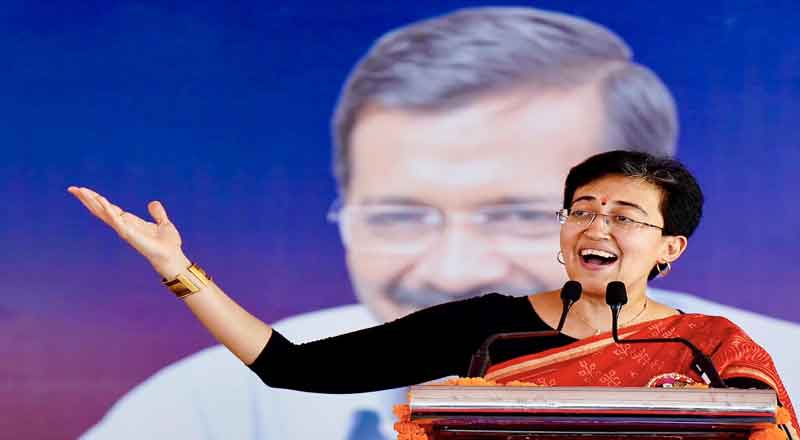Atishi, the 43-year-old Aam Aadmi Party (AAP) leader, officially took charge as the Chief Minister of Delhi on Saturday, following the resignation of Arvind Kejriwal. In a symbolic and emotional gesture, Atishi compared her new role to the character of Bharat from the Hindu epic Ramayana, emphasizing her commitment to govern in Kejriwal’s absence. As she steps into the role of the eighth Chief Minister of Delhi, Atishi vows to uphold Kejriwal’s legacy and continue his governance until the upcoming elections in February.
Atishi’s Symbolic Gesture of Loyalty
Upon taking office, Atishi underscored her loyalty to Kejriwal by placing an empty chair next to hers during her first day in charge. This, she said, was a gesture to signify that the chair “belongs to Arvind Kejriwal,” who remains the driving force behind her leadership. Atishi expressed confidence that the people of Delhi would reinstate Kejriwal as Chief Minister after the elections.
“My situation is like that of Bharat when Lord Shri Ram went into exile,” Atishi remarked. “Bharat ruled with Lord Ram’s sandals on the throne, and I will govern with Arvind Kejriwal’s vision in his absence.”
Sworn in Alongside Key Cabinet Members
Atishi was sworn in as Chief Minister alongside her Council of Ministers in a ceremony at the Raj Niwas. The new cabinet, a blend of familiar faces and newcomers, is tasked with overseeing various portfolios. Key ministers, including Saurabh Bharadwaj, Gopal Rai, and Imran Hussain, retained their roles from the Kejriwal government.
Atishi herself continues to manage 13 critical portfolios, including education, finance, power, and the Public Works Department (PWD). Saurabh Bharadwaj, who holds eight portfolios, took charge of health and urban development, while Gopal Rai retained his environment and general administration duties. Newcomer Mukesh Ahlawat has been entrusted with departments related to labor, SC/ST welfare, and employment.
A Milestone for Women Leadership in Delhi
With her appointment, Atishi becomes the 17th female Chief Minister in India and the third to lead Delhi, following the footsteps of the late Sushma Swaraj and Sheila Dikshit. This marks a significant moment in Delhi’s political landscape as she takes on the responsibility of governing one of the country’s most populous cities.
The transition comes after Arvind Kejriwal’s resignation, which was accepted by President Droupadi Murmu. Kejriwal, under legal constraints, stepped down from his position amid the backdrop of ongoing judicial proceedings. Despite stepping away from formal office, Kejriwal continues to wield considerable influence, a fact recognized both within AAP and by political opponents.
Challenges and Criticism Ahead
Atishi’s tenure, though temporary, comes with a list of pending projects and initiatives that the new cabinet will have to address before Delhi heads to the polls in February 2024. These include ongoing infrastructure projects, education reforms, and social welfare schemes that were the hallmark of the Kejriwal government.
However, the Bharatiya Janata Party (BJP) has already raised criticism, calling Atishi a “puppet” leader. BJP spokesperson Shehzad Poonawalla referred to her as the “new Manmohan Singh,” suggesting that while Atishi may hold the title of Chief Minister, the real power lies with Kejriwal, who will continue to lead behind the scenes.
“The real power will be with Arvind Kejriwal—he will be the de facto CM, and Atishi will be de jure CM,” said Poonawalla. The BJP also took a swipe at Kejriwal’s governance, accusing the AAP of building extravagant infrastructure like the “Sheeshmahal” and questioned Atishi’s political stance on national security issues.
Delhi’s Leader of the Opposition Vijender Gupta echoed similar sentiments, describing Atishi’s leadership as a “dummy government” with Kejriwal acting as a “remote-control” leader.
Atishi’s Vision for Delhi
Despite the criticism, Atishi is determined to govern effectively in the months leading up to the elections. She inherits a city with multiple challenges, including air pollution, infrastructural demands, and economic recovery post-COVID. Her work in the Kejriwal government, particularly in education and finance, has earned her a reputation as a capable and efficient leader.
Atishi has pledged to continue AAP’s focus on education, healthcare, and social welfare, while also managing the city’s development projects. Her role, though temporary, will be pivotal in maintaining the momentum of Kejriwal’s governance, ensuring that Delhi remains on track until the elections.
As the city prepares for the upcoming electoral battle, Atishi’s leadership will be closely watched. Her symbolic gesture toward Kejriwal not only signals her loyalty but also sets the tone for a government determined to follow through on its promises despite the challenges ahead.
(With inputs from agencies)





